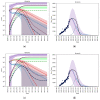Could a New COVID-19 Mutant Strain Undermine Vaccination Efforts? A Mathematical Modelling Approach for Estimating the Spread of B.1.1.7 Using Ontario, Canada, as a Case Study
- PMID: 34204918
- PMCID: PMC8227606
- DOI: 10.3390/vaccines9060592
Could a New COVID-19 Mutant Strain Undermine Vaccination Efforts? A Mathematical Modelling Approach for Estimating the Spread of B.1.1.7 Using Ontario, Canada, as a Case Study
Abstract
Infections represent highly dynamic processes, characterized by evolutionary changes and events that involve both the pathogen and the host. Among infectious agents, viruses, such as Severe Acute Respiratory Syndrome-related Coronavirus type 2 (SARS-CoV-2), the infectious agent responsible for the currently ongoing Coronavirus disease 2019 (COVID-2019) pandemic, have a particularly high mutation rate. Taking into account the mutational landscape of an infectious agent, it is important to shed light on its evolution capability over time. As new, more infectious strains of COVID-19 emerge around the world, it is imperative to estimate when these new strains may overtake the wild-type strain in different populations. Therefore, we developed a general-purpose framework to estimate the time at which a mutant variant is able to take over a wild-type strain during an emerging infectious disease outbreak. In this study, we used COVID-19 as a case-study; however, the model is adaptable to any emerging pathogen. We devised a two-strain mathematical framework to model a wild- and a mutant-type viral population and fit cumulative case data to parameterize the model, using Ontario as a case study. We found that, in the context of under-reporting and the current case levels, a variant strain was unlikely to dominate until March/April 2021. The current non-pharmaceutical interventions in Ontario need to be kept in place longer even with vaccination in order to prevent another outbreak. The spread of a variant strain in Ontario will likely be observed by a widened peak of the daily reported cases. If vaccine efficacy is maintained across strains, then it is still possible to achieve high levels of immunity in the population by the end of 2021. Our findings have important practical implications in terms of public health as policy- and decision-makers are equipped with a mathematical tool that can enable the estimation of the take-over of a mutant strain of an emerging infectious disease.
Keywords: COVID-19 pandemic; emerging infectious diseases; mathematical model; mutant strains.
Conflict of interest statement
The funders had no role in the design of the study; in the collection, analyses, or interpretation of data; in the writing of the manuscript, or in the decision to publish the results.
Figures










References
-
- Stern A., Andino R. Viral Pathogenesis. Elsevier; Amsterdam, The Netherlands: 2016. Viral evolution: It is all about mutations; pp. 233–240.
LinkOut - more resources
Full Text Sources
Research Materials
Miscellaneous

